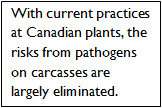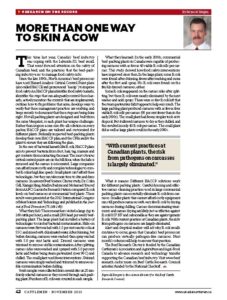More Than One Way to Skin a Cow
This article written by Dr. Reynold Bergen, BCRC Science Director, originally appeared in the November 2013 issue of Canadian Cattlemen magazine and is reprinted with permission.
This time last year, Canada’s beef industry was coping with the Lakeside-XL beef recall. That event focused attention on the safety of Canadian beef, and the practices that the beef packing industry uses to manage food safety risks.
Since the late 1990’s, North America’s beef processors have used Hazard Analysis Critical Control Point plans (also called HACCP, and pronounced “hassip”) to improve food safety. A HACCP plan identifies food safety hazards, identifies the steps that can adequately control those hazards, actively monitors the controls that are implemented, outlines how to fix problems that arise, develops ways to verify that these management practices are working, and keeps records to document that these steps are being done right. Not all packing plants are designed and built from the same blueprint, so each plant has unique challenges. Rather than impose a one-size-fits-all solution on every packer, HACCP plans are tailored and customized for different plants. Federally inspected beef packing plants develop their own HACCP plan, and the CFIA audits the plant to ensure they are following the plan.
In the case of bacterial hazards like E. coli, HACCP plans aim to prevent bacteria from dust, hair, tag, manure and gut contents from contacting the meat. The most obvious critical control points are on the kill floor, when the hide is removed and the carcass is eviscerated. Large companies can afford more costly and complex technologies to combat E. coli at high line speeds. Small plants can’t afford these technologies, but they can take more time to skin and dress carcasses. In a recent Beef Science Cluster study, Dr. Colin Gill, Xianqin Yang, Madhu Badoni and Mohamed Youssef from AAFC’s Lacombe Research Station compared E. coli levels on beef carcasses at commercial beef plants. These results were presented at the 2012 International Congress of Meat Science and Technology, and published in the Journal of Food Protection (75:144-149).
What They Did:
These researchers visited a large (up to 280 cattle per hour), and a small (200 head per week) beef packing plants. The large plant had installed a battery of technologies to combat bacterial contamination. Hide-on carcasses were first washed with 1.5% caustic soda at 55oC and rinsed with chlorinated water. After skinning, but before dressing, carcasses were washed then spray-washed with 5% lactic acid. Dressed carcasses were trimmed to remove visible contamination. After splitting, carcass sides were washed and sprayed with 5% lactic acid before being steam pasteurized (over 90oC) and chilled. The small plant used fewer interventions. Skinned carcasses were simply washed and trimmed to remove visible contamination before chilling.
Swab samples were collected from several sites on 25 randomly selected carcasses as they moved through each packing plant. Numbers of E. coli were counted in each sample.
What They Learned:
In the early 2000’s, commercial beef packing plants in Canada were capable of producing carcasses with as few as 40 viable E. coli cells per carcass. This study showed how food safety interventions have improved since then. In the large plant, some E. coli were found after skinning, fewer after washing and none after the first acid spray. No E. coli were found on the freshly dressed carcasses, either. Some E. coli reappeared on the carcass sides after splitting, but these E. coli were nearly eliminated by the next washes and acid sprays. There were so few E. coli left that the steam pasteurizer didn’t appear to help very much. The large packing plant produced carcasses with as few as 4 viable E. coli cells per carcass (90% fewer than in the early 2000’s). The small plant had fewer, simpler tools at its disposal. But it allowed carcasses to dry as they chilled, and this resulted in only 40 E. coli per carcass. The small plant did as well as large plants could in the early 2000’s.

What It Means:
Different HACCP solutions work for different packing plants. Careful dressing and effective carcass cleaning practices used in large commercial packing plants can essentially eliminate E. coli from carcasses. Smaller plants that cannot afford costly equipment can still produce carcasses with very few E. coli by drying carcasses during chilling. Carcass decontaminating treatments and carcass drying are likely just as effective against E. coli O157:H7 and Salmonella as they are against generic E. coli. With current practices at Canadian plants, the risks from pathogens on carcasses are largely eliminated.
Alert and skeptical readers will ask why E. coli recalls continue to occur, given that Canada’s beef processors can produce virtually pathogen-free carcasses. Next month’s column will help to answer that question.
Click here to subscribe to the BCRC Blog and receive email notifications when new content is posted.
The sharing or reprinting of BCRC Blog articles is welcome and encouraged, however this article requires permission of the original publisher.
We welcome your questions, comments and suggestions. Contact us directly at info@beefresearch.ca or generate public discussion by posting your thoughts below.
